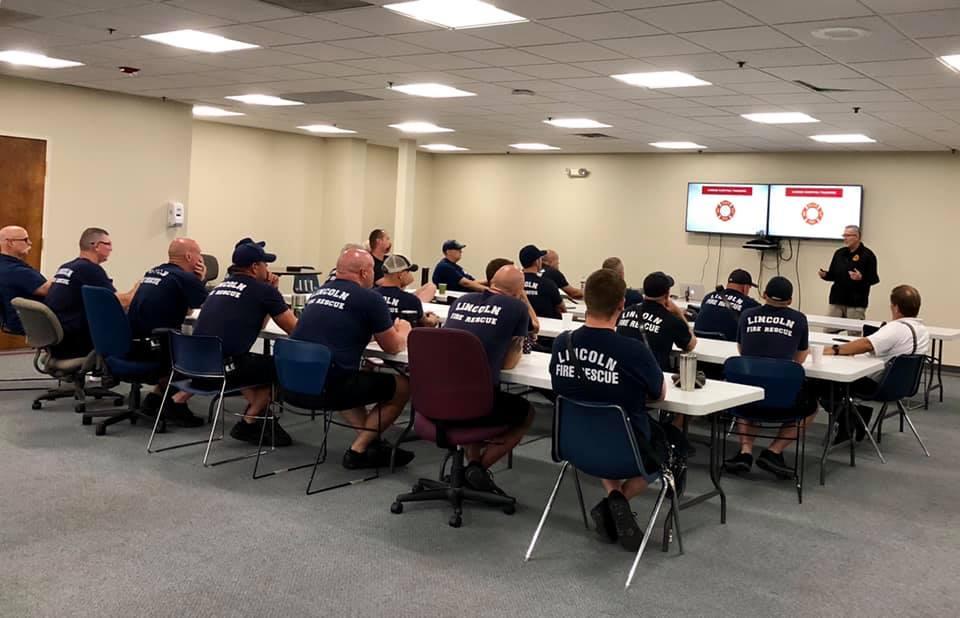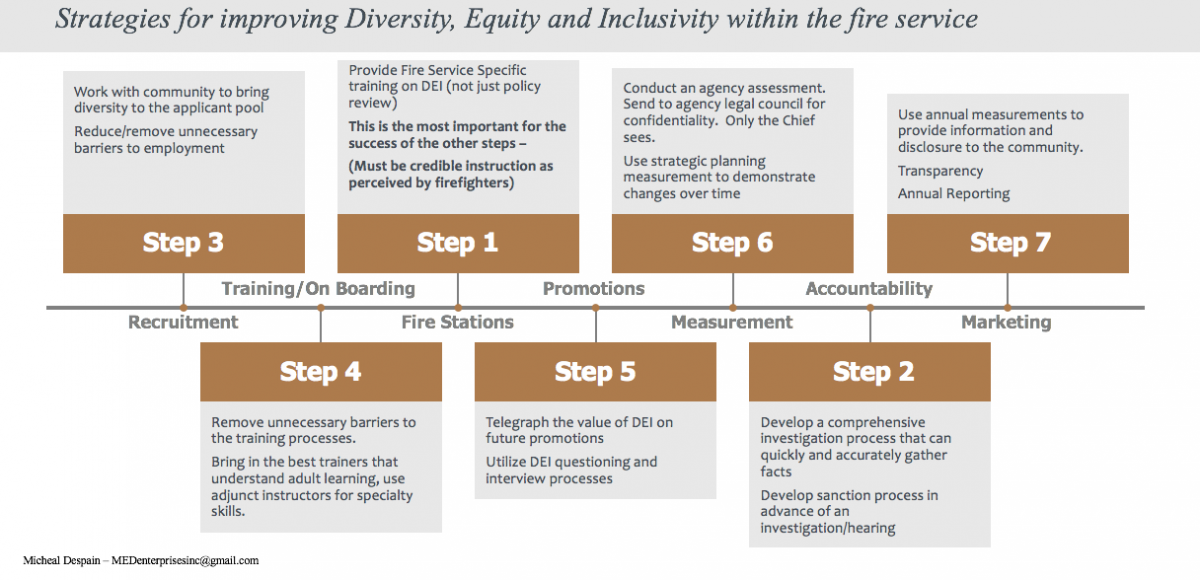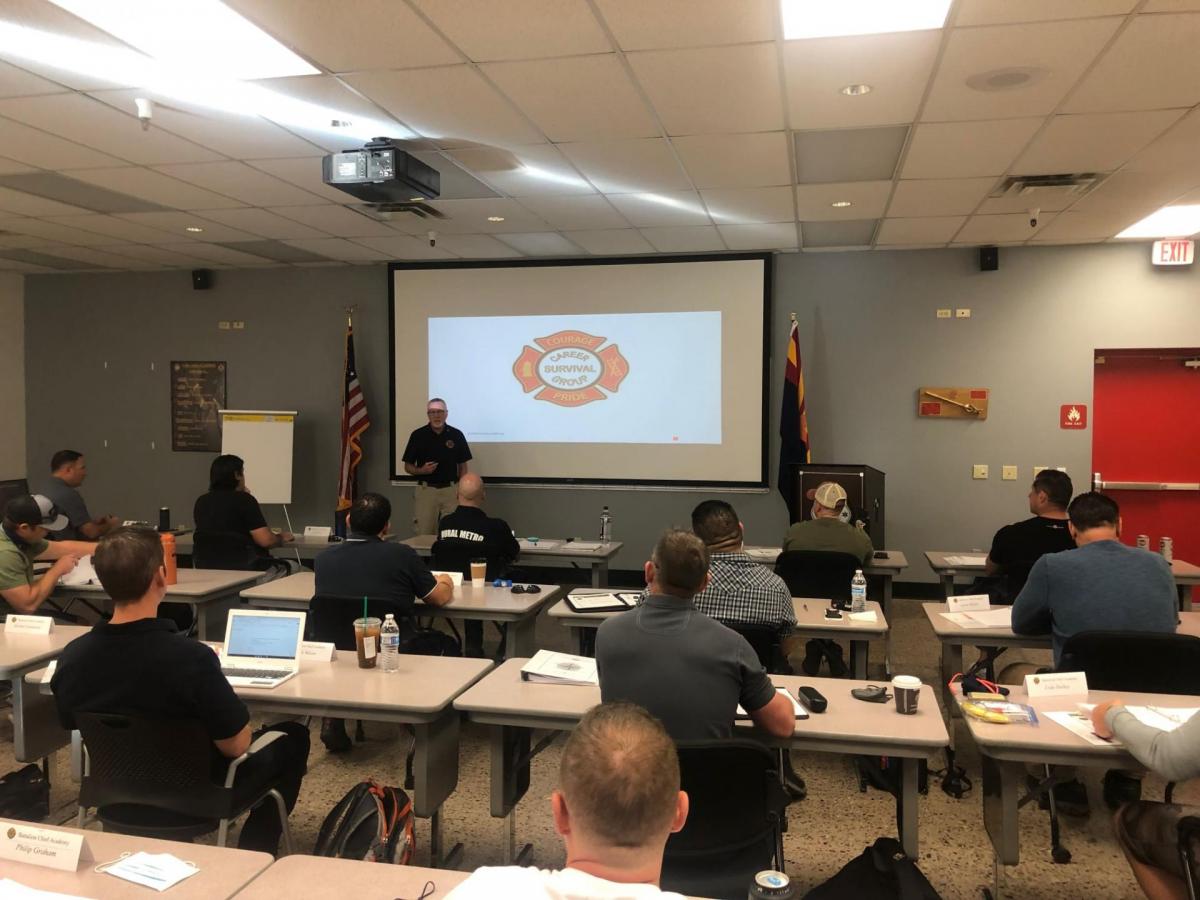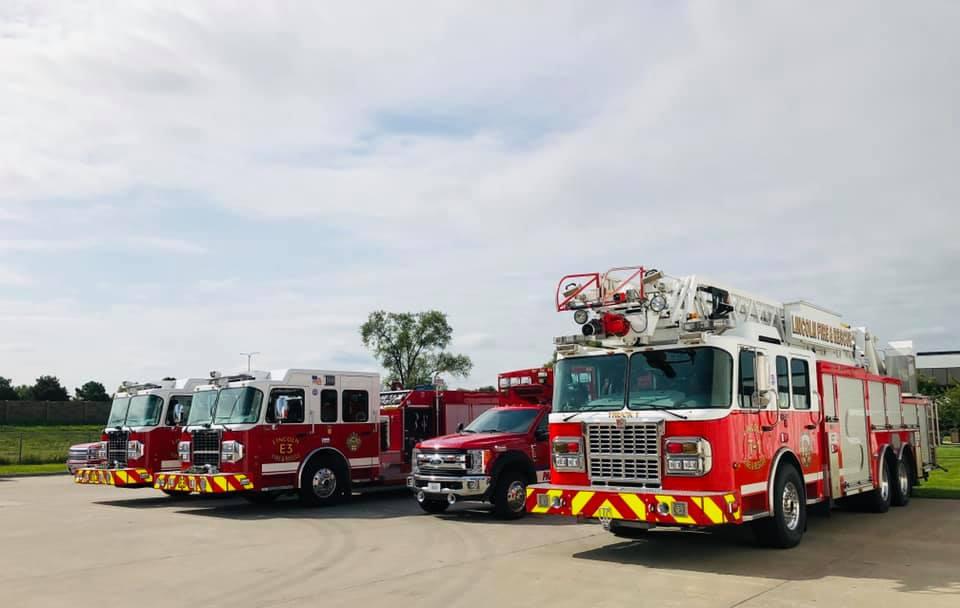Diversity, equity, and inclusion in the fire service: Seven steps agencies can take
Eric Rosoff is the executive manager of Career Survival Group and former law enforcement professional; he can be reached at erosoff@careersurvivalgroup.com. Mike Despain is a former fire chief and League of California Cities board member and a presenter for Career Survival Group; he can be reached at medenterprisesinc@gmail.com. Brian Lee-Mounger Hendershot is the managing editor for Western City magazine; he can be reached at bhendershot@calcities.org.
Firefighters are some of the nation’s most trusted professionals, even more than healthcare workers, first responders, and teachers. However, within the fire service ranks, the trust is more fragile when it comes to creating more diverse, equitable, and inclusive workplaces. The very things that have made fire departments successful — a strong sense of brotherhood, an emphasis on measurable operational results, and a close living-working environment — are often the very things that make attempts to increase diversity, equity, and inclusion (DEI) inside fire stations uniquely challenging.
Issues with equity and inclusion tend to be internal — firefighter-to-firefighter — meaning that until relatively recently the industry has largely escaped public scrutiny. In fact, 20 years ago the public opinion of firefighters was so positive that it was difficult to even find an attorney who would take a workplace environment-based case against a fire department.
The professionalization of the fire service workplace is a relatively recent change. Unlike other city departments, firefighters live with the people they work with, sometimes for up to 48 consecutive hours. Prior to a nationwide, sustained professional workplace effort, it was not uncommon for fire stations to have sexually explicit or inappropriate materials visible throughout the living quarters. Although this type of behavior is no longer tolerated — in part because of a growing number of lawsuits, consent decrees, and staff attrition — this “locker room” mentality is still commonplace, if not as visible, in some stations.
Ribbing or insulting recruits with the intent of increasing comradery may be seen as funny to some, but constant, derogatory name-calling and microaggressions can lead to harassment-related lawsuits. Given that 96% of firefighters are white and 82% are men, this can be particularly problematic.
Fire service agencies will commonly report a “multipronged” approach to improving diversity, equity, and inclusion with a heavy emphasis on recruitment along with the formation of diversity committees. These are certainly important steps, but they often do not move the needle much towards the expected outcomes.
A strategic DEI plan should ideally include several specific actions, each designed to accomplish specific tasks while also supporting the other actions and the overarching strategic goals of the agency. These actions can be initiated at any time in the DEI process and/or be in progress simultaneously. However, the immediate emphasis must be on workplace training that is specifically tailored for firefighters.
1. Meaningful workplace training
Workplace environment training, including DEI training, in the fire service typically takes place in two forms: through an internet-based video or in-person training from a human resource professional or attorney. Both are often conducted on an individual level, which runs counter to how firefighters live, work, and drill. Such training, however well-intentioned, frequently fails to change long-established behaviors.
As DEI professionals know well, there is no “one size fits all” workplace training. In the fire service, training should ideally be conducted at the crew or battalion level and led by a trusted member of the fire service — someone who “gets” what the job is like. Simply put, training must be retooled and revisited in such a way that it addresses the unique circumstances of fire departments and meets state requirements.
Workplace training must be a priority. Failing to meet workplace expectations can derail all other DEI efforts, present a significant liability to taxpayers, and compromise public trust.
2. Realistic and reasonable workplace investigations
Agencies must also promote a culture where employees and supervisors feel confident when addressing all workplace infractions — major or minor. Current processes in some agencies may discourage early intervention, thus allowing hostile work environments to develop. Changing company culture is difficult, even in the best of circumstances: When the workplace requires sharing accommodations for 48 hours or more, such a change may seem impossible. There is often a shunning and isolation that goes with pushing back against established norms, even at the supervisor level. Individuals tend to let “minor” infractions go without intervention for fear that saying something will result in:
- An intrusive and stressful HR investigation
- Being ostracized or isolated by co-workers
- Major punitive administrative actions for themselves or their coworkers
- Adverse impacts on morale and the day-to-day efficiency of the work unit
As a result, prohibited behavior may continue unchecked for months or even years, before eventually manifesting as the definition of a hostile work environment. A review of workplace environment claims and lawsuits usually reveals a pattern of relatively “minor” infractions which, had they been addressed at the moment, would likely never have developed into a claim or suit.
Fire department leaders should be encouraged to quickly address uncomfortable situations. In the parlance of fire operations, supervisors have the tools necessary to put out small workplace fires before they consume the entire department. And fire department leaders should be praised for doing so, just as they would for saving a home from burning down.
In fact, all employees should be confident that addressing minor isolated incidents or petty slights will not result in intrusive investigations, personnel actions, or any discernable change in the day-to-day work product of the unit. And they must be able to do so without fear of retaliation.
3. Action: Agency assessment
An honest assessment of agency culture is necessary to establish an accurate baseline of where an agency is related to DEI processes, challenges, and expectations. An accurate assessment helps prioritize the efficient use of available resources and can provide measurements by which all DEI efforts can be evaluated.
Focusing on measurable outcomes is an important first step. Based on previous complaints and investigations, how has the culture of the department changed? Has the number of lawsuits, complaints, and investigations decreased, and was that related to new DEI policies? Do supervisors feel empowered to prevent bad behavior and provide disciplinary action and reporting? What is the demographic makeup of our applicant pool compared to previous years?
The best practice is to conduct a series of surveys, interviews, and reviews of DEI factors, ideally using trained experts from outside the fire department. The final product could be a report for a department head, city manager, and legal counsel and should provide a clear picture of where the agency is regarding diversity, equity, and inclusion.
4. Partner with community organizations and other departments to diversify applicant pool
With agencies struggling to retain existing members, it is no surprise that they are also struggling with recruitment. In some regions, applicant pools have declined to a point where merely applying for a job all but ensures getting hired. The first step fire service departments can take is to reach out to other city departments who are not struggling with recruitment, but whose skills overlap, such as parks and recreation or law enforcement.
However, the best practice is to seek the assistance of the community being served. Fire chiefs and city leaders should work with local community leaders to bring more diversity to the applicant pool by reducing or removing unnecessary barriers to employment, such as outdated, manipulative, or even irrelevant tests that do not best represent the requirements of the job.
For example, in their ground-breaking study focusing on the lack of gender diversity in fire service, Felix Danbold and Corinne Bendersky found that fire service recruiting frequently suggested a constant exposure to extreme danger and that entry-level testing processes focused on difficult physical tasks requiring significant upper body strength. However, a review of typical fire service tasks quickly reveals these efforts are not at all representative of the actual job.
In a survey of fire chiefs, physical strength is often cited as the third most important requirement, right after a desire to serve and strong interpersonal skills. Additionally, advances in technology and even fabrics have made it easier for firefighters to do their job, even while wearing full gear. This is not to say the job is not dangerous and requires strength: It is just that the recruiting and testing efforts are not always reflective of what is in fact required of a firefighter. This is doubly true for women, who have cited the “boy’s culture” and “non-caregiver friendly environment” as a reason for not applying.
5. Remove unnecessary barriers to training
Although firefighting technology has evolved, training by some departments has remained frozen in time. Some instructors continue to yell, demean, and insult recruits to replicate tension that firefighters may face during emergencies. However, there are ways to increase stress — such as videotaping and timing trainees during drills — in a way that does not create an environment that encourages hostility.
Furthermore, the actual day-to-day job of a firefighter rarely involves pulling a person out of a burning building on their shoulder. Roughly 80% of all fire service calls are related to medical services. Firefighters are often either assisting paramedics, comforting families, directing traffic, or related functions. None of those things require extraordinary upper body strength. Instead, they require situational awareness and empathy, which are rarely emphasized in training or recruitment.
To be sure, there are minimum physical requirements that must be met in order to effectively carry out the duties of a firefighter. However, requirements should not go beyond what is necessary, as this may discourage certain people from applying. Academies must be dedicated to assuring the most current applications of the job are being taught through methods that provide the best chance for trainees to thrive.
6. Telegraph the importance of DEI for future promotions
Additionally, leaders should ensure that diversity, equity, and inclusion expectations are part of all hiring and promotional processes. The message must be clear that the agency values an understanding and application of DEI factors as much as operational capabilities. There is substantial evidence that when promoting officers, people skills may be more important to the long-term cultural health of the organization than strictly operational capabilities.
Written and oral exams for entry-level and promotion should include questions developed by community-based partnerships and tie directly to the agency’s DEI process. These questions keep the community involved in the DEI process and carry the message of the agency’s commitment to DEI.
7. Keep moving forward
There is no such thing as a completely perfect working environment, and in departments that have been plagued with unhealthy working conditions for decades, this will not be undone in a matter of months. A good practice to assess improvement is to use annual measurements for accurate and unbiased DEI reporting. These annual reports can promote public trust through transparency, promote recruitment, and maintain DEI-based momentum within the agency. A robust DEI strategic plan should be the point of pride of any city government.
Crucially, implementing a robust DEI plan means that harassment claims may increase, at least in the short term. Creating a culture that fosters talking about uncomfortable situations invariably means that people who did not feel comfortable previously will now feel comfortable calling out bad behavior. However, if leaders continue to promote a culture that encourages inclusivity, empathy, and dignity, while also updating their training, recruitment, promotion, and assessment methods, complaints will decrease. And if city leaders get it right, they can apply those lessons to all aspects of community service.




